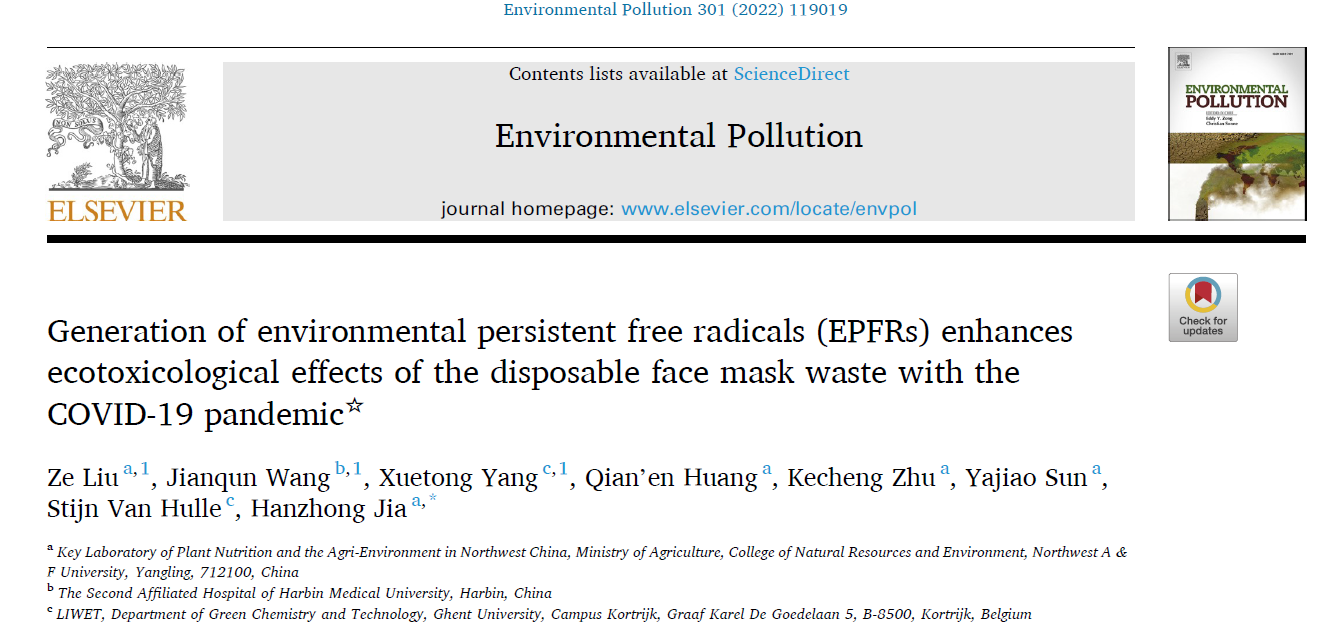
1.研究背景
随着SARS-COV-2在全球范围内的蔓延,为避免冠状病毒的传播,建议佩戴口罩预防病毒感染。正如世界卫生组织(WHO)预测的那样,在当前大流行期间,全球一次性口罩(DPFs)的月需求量接近9000万个。全球对口罩的需求激增,导致口罩产量空前增加。然而,这一全球健康危机造成了一个额外的问题,即一次性口罩废弃物总量迅速增加。当DPFs暴露于环境后,在光照射、机械磨损、氧化或生物降解作用下,它可能成为微塑料(MPs)的潜在来源。因此,要综合评价DPFs暴露于环境后MPs的释放以及其组成物质浸出所造成的生态影响,应考虑环境持久性自由基(EPFRs)的产生及其毒性作用。然而,在评估EPFRs产生方面的工作有限,因此评估DPFs与EPFRs相关的环境影响方面的信息尤为重要。
As SARS-COV-2 spreads around the world, it is recommended to wear a face mask to prevent the spread of the coronavirus. As predicted by the World Health Organization (WHO), global monthly demand for disposable face masks (DPFs) during the current pandemic is approaching 90 million. The surge in global demand for masks has led to an unprecedented increase in their production. However, this global health crisis has created an additional problem: the rapid increase in the amount of disposable mask waste. When exposed to the environment, DPFs may be a potential source of microplastics (MPs) under light irradiation, mechanical wear, oxidation or biodegradation. Therefore, the production of environmentally persistent free radicals (EPFRs) and their toxic effects should be considered to comprehensively evaluate the ecological effects of MPs release and leaching of their components after DPFs exposure to the environment. However, limited work has been done to assess EPFRs production, making it particularly important to assess information on the environmental impacts of DPFs associated with EPFRs.
2.研究结果
随着暴露时间的增加,DPFs向渗滤液中释放的MPs增多。其中,外科口罩的MPs含量从5 d渗滤液中的28 items/L增加到15 d渗滤液中的231 items/L。研究发现,随着浸泡时间的延长,渗滤液中碎片化的小颗粒(< 40 μm)含量增加。渗滤液中检测到Co、Cu、Ni、Sr、Ti和Zn等重金属以及包括苯乙酮、DTBP和双(2-乙基己基)邻苯二甲酸酯在内的有机物。此外,与N95口罩渗滤液相比,外科口罩渗滤液中发现的各种金属(如Cd、Cr、Mn和Pb)和有机物(如乙酰柠檬酸三丁酯和苯甲醛)含量更多。从塑料相关化学物质的角度来看,DPFs是MPs、金属和有机物的来源,暴露于水环境后可能造成生态系统风险。值得注意的是,在DPFs上检测到以碳为中心的EPFRs,这可能与DPFs中所含金属和有机物之间的电子转移反应有关。为了评估DPF废物潜在的不良影响,进一步进行了体外毒性评估,证明DPF渗滤液可引起细胞毒性和氧化应激。
disposable face mask waste with the COVID-19 pandemic by not only leaching metals and organics and releasing MPs but also the formed EPFRs. More MPs were released to the leachates from the DPFs with the increasing of the exposure time, for example, the abundance of MPs of surgical mask was enhanced from 28 items/L in 5 d-leachate to 231 items/L in 15 d-leachates. It is found that MPs were fragmented with soaking time as the abundance of smaller MPs (e.g. < 40 μm) in leachates was increased. Metals (including Co, Cu, Ni, Sr, Ti and Zn) and organics (including acetophenone, DTBP and bis(2-ethylhexyl) phthalate) were commonly presented in the leachates. Furthermore, more various metals (like Cd, Cr, Mn and Pb) and organics (like tributyl acetylcitrate and benzaldehyde) were found in surgical masks leachates than in N95 respirators leachates. From the perspective of plastic-related chemicals, the DPFs was confirmed as a source of MPs, metals and organics, and hence could cause an ecosystem risk after exposing to the aquatic environment. Significantly, the carbon-centered EPFRs were detected to be generated on the DPFs, which could be attributed to the electron-transfer reaction between metals and organics contained in the DPFs. In order to estimate the potential adverse effects of the DPF waste, we further conducted in vitro toxicity assessment and demonstrated that the DPFs leachate could cause cytotoxicity and oxidative stress.
3.研究意义
这项工作为DPFs暴露在水中后产生的EPFRs提供了详细的数据。这项研究有助于更好地了解DPFs暴露于水体系中的环境影响和毒性风险。
This work provides detailed data and systemic estimation to the generated EPFRs after DPFs exposure to water. These findings contributed to bridging the knowledge gap in better understanding the
environmental effects and toxic risk of DPFs waste exposure to the aquatic environment.
文章来源:Liu, Z., Wang, J., Yang, X., Huang, Q.e., Zhu, K., Sun, Y., Van Hulle, S., Jia, H., 2022. Generation of environmental persistent free radicals (EPFRs) enhances ecotoxicological effects of the disposable face mask waste with the COVID-19 pandemic. Environmental Pollution 301. https://doi.org/10.1016/j.envpol.2022.119019.
 公众号
公众号